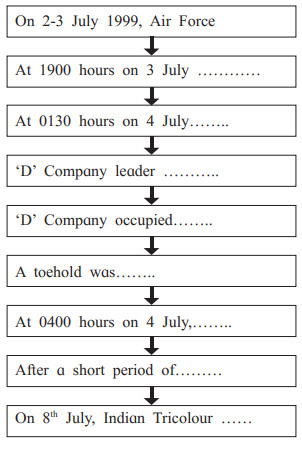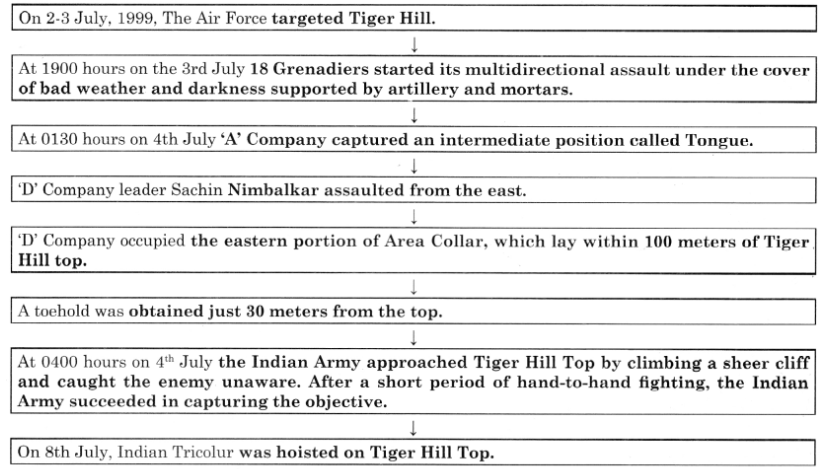Tiger Hills
Brainstorming – Solutions
(A1)
(i) Narrate in your own words a similar account based on the text to the class.
Imagine a tense yet thrilling scene set during the Kargil War. One day, our unit, the 18 Grenadiers, was tasked with capturing Tiger Hill, a towering peak dominating the Srinagar-Kargil-Leh highway. After resting from our earlier victories at Tololing, we began planning with 8 Sikh and a team from the High Altitude Warfare School. For a week, we scouted the enemy’s defenses and found routes up the steep slopes. Our commanding officer crafted a detailed artillery plan, positioning guns to hit every target precisely. On the assault day, July 3, 1999, under the cover of darkness and bad weather, we launched a multi-sided attack. Captain Sachin Nimbalkar led ‘D’ Company up a treacherous cliff, surprising the enemy, while Lieutenant Balwan Singh’s team gained a foothold near the top. After intense hand-to-hand combat and heavy artillery support, we captured Tiger Hill by 0400 hours on July 4. The victory, confirmed later, lifted our spirits and the nation’s, marking a turning point in the war.
(ii) Imagine that you are about to interview the writer. Write 10 to 15 questions regarding the operation.
- General Malik, what inspired you to document the Kargil War in “Kargil: From Surprise to Victory”?
- How did you maintain objectivity while describing the emotional intensity of the Tiger Hill operation?
- What were the biggest challenges faced by 18 Grenadiers during the assault on Tiger Hill?
- How did the multidirectional assault strategy come about, and why was it chosen?
- Can you share details about the role of Captain Sachin Nimbalkar and Lieutenant Balwan Singh in capturing the hill?
- How did the artillery and Air Force coordination contribute to the success at Tiger Hill?
- What impact did live media coverage have on the morale of the soldiers and the public?
- Were there any unexpected obstacles during the planning or execution of the Tiger Hill mission?
- How did the capture of Tiger Hill influence the overall outcome of the Kargil War?
- What lessons from Tiger Hill do you think are crucial for future military operations?
- How did you feel when you received confirmation of the victory on July 4, 1999?
- What role did the High Altitude Warfare School team play in supporting the assault?
- How did the enemy’s fortifications affect the strategy to recapture Tiger Hill?
- What message do you hope readers take away from your account of this battle?
- Were there any personal experiences from the war that shaped your writing of this chapter?
(A2)
(i) List any four facts which made the capturing of Tiger Hill a national challenge.
- The sharp triangular top of Tiger Hill was visible from the highway and seemed nearly impossible to capture.
- Its strategic location, 10 kilometers north of the Srinagar-Kargil-Leh highway, allowed the enemy to dominate key routes.
- The hill was well-fortified by the enemy, making it a difficult target to assault.
- The media projected the operation as a national challenge, increasing public and political pressure for success.
(ii) Different arms and ammunition are mentioned in the excerpt. Find their names.
- Bofors guns
- 122-mm multibarreled Grad rocket launchers
- Mortars
- Individual guns
(iii) Wars are not fought only on the battlefield. Comment.
Wars extend beyond physical combat, involving psychological, strategic, and informational battles. In the Tiger Hill operation, the media’s live coverage boosted national morale and pressured the enemy psychologically. Diplomatic efforts, like informing the Prime Minister and the US President before Nawaz Sharif’s meeting, shaped the war’s global perception. The planning and coordination between artillery, air force, and ground troops also highlight how wars are won through intellect, communication, and support systems, not just battlefield clashes.
(iv) Prompt reporting is of strategic importance during a war. Refer to the above extract and explain.
Prompt reporting played a key role in the Tiger Hill victory. On July 4, 1999, Krishan Pal’s early morning call at 0600 hours informed General Malik of the capture, allowing quick consultation with Nirmal Chander Vij. By 0730 hours, Mohinder Puri’s confirmation enabled swift communication to Brajesh Mishra and the Prime Minister, who addressed the public at 1000 hours. This timely update also ensured the world knew of the success before Nawaz Sharif’s meeting with Bill Clinton, influencing international opinion and pressuring Pakistan. Fast reporting thus aided strategic decision-making and morale.
(iv) Read the extract and do the following activities. Make a list of the preparations made for an assault on Tiger Hill.
(a) Throughout the last week of June 1999, 18 Grenadiers probed to establish the extent of the enemy’s defences.
(b) They also explored to scout for suitable routes for the assault.
(c) After confirming the multidirectional assault as the best strategy, the commanding officer of 41 Field Regiment drew up an elaborate artillery fire plan.
(d) Individual guns were ranged so as to cover each objective.
(e) Bofors guns were used in a direct firing role with inspiring accuracy.
Explanation: These preparations reflect the detailed reconnaissance, strategic planning, and coordination of resources by 18 Grenadiers and supporting units, ensuring a well-executed assault on Tiger Hill.
(v) Complete the flow chart showing the events on the day of the assault.
Answer :-
(vi) Rewrite the given statements in their order of occurence. The most difficult task of maintaining the hold on Tiger Hill was achieved in this way:
(a) 8 Sikh was ordered to attack and capture Helmet and India Gate.
(b) Bodies of the Pakistani soldiers were collected and buried appropriately.
(c) During the ferocious artillery duels the Grenadiers hung on their precarious perch with grit and determination.
(d) Sikh fought back successfully two counterattacks with forty to fifty personnel.
(e) An adhoc column of 8 Sikh climbed the steep rock and captured India Gate.
(f) In spite of heavy casualties, 8 Sikh captured Helmet on 5 July.
Answer:-
(a) 8 Sikh was ordered to attack and capture Helmet and India Gate.
(e) An adhoc column of 8 Sikh climbed the steep rock and captured India Gate.
(f) In spite of heavy casualties, 8 Sikh captured Helmet on 5 July.
(d) 8 Sikh fought back successfully two counterattacks with forty to fifty personnel.
(c) During the ferocious artillery duels, the Grenadiers hung on their precarious perch with grit and determination.
(b) Bodies of the Pakistani soldiers were collected and buried appropriately.
(A3)
(i) Discuss the meanings of the following idioms/phrases and use them in your own sentences.
(a) To hit the bull’s eye
Meaning:To achieve exactly the desired result; to be exactly right or successful.
Sentence:The Air Force hit the bull’s eye by destroying the enemy bunkers on Tiger Hill with perfect accuracy.
(b) To be taken by surprise
Meaning:To be shocked or caught off guard unexpectedly.
Sentence:The enemy was taken by surprise when Indian soldiers launched the assault under the cover of darkness.
(c) To get a toehold
Meaning:To gain a small or initial position that can be built upon; a slight or initial advantage.
Sentence:The Ghatak platoon managed to get a toehold just 30 meters from the top of Tiger Hill.
(d) Under the cover of
Meaning:Hidden or protected by something, such as darkness, fog, or a false pretense.
Sentence:The soldiers began their advance under the cover of bad weather and darkness.
(e) A spell of
Meaning:A short period of time during which a particular activity or weather condition occurs.
Sentence:After a spell of intense hand-to-hand combat, the Indian troops captured the enemy position.
(ii) Read the following words :
Brigadier, Commander, capture, evicting, enemy, defense All these words are related to the war affairs and war. Find more such words from the passage.
Answer:-
(a) Assault
(b) Mission
(c) Fortified
(d) Artillery
(e) Bombardment
(f) Counterattacks



Leave a Reply